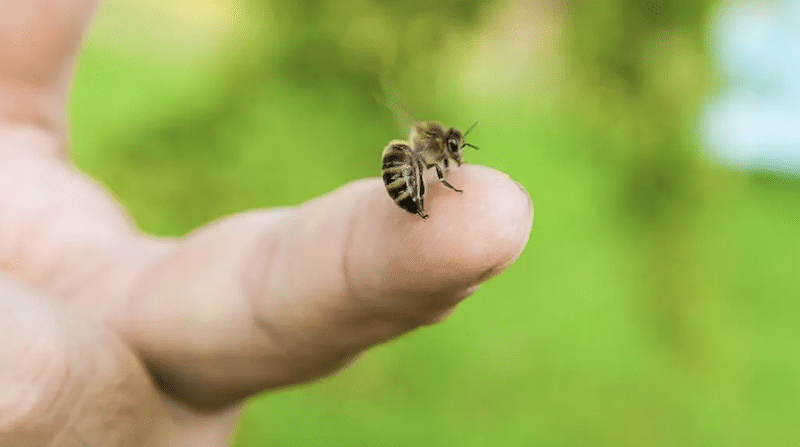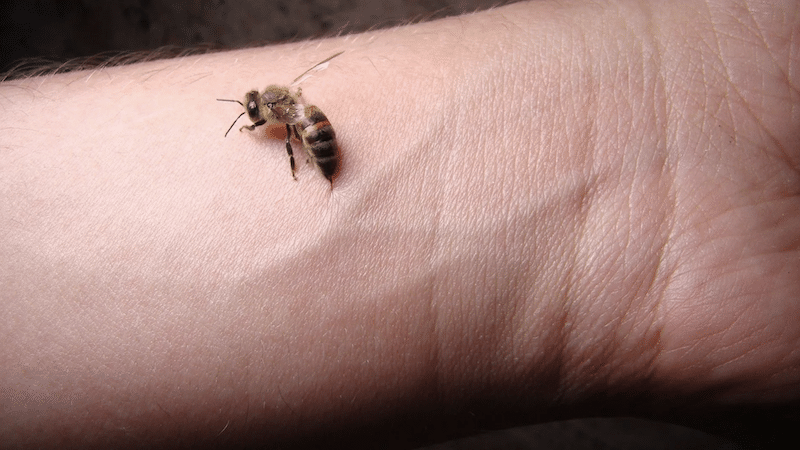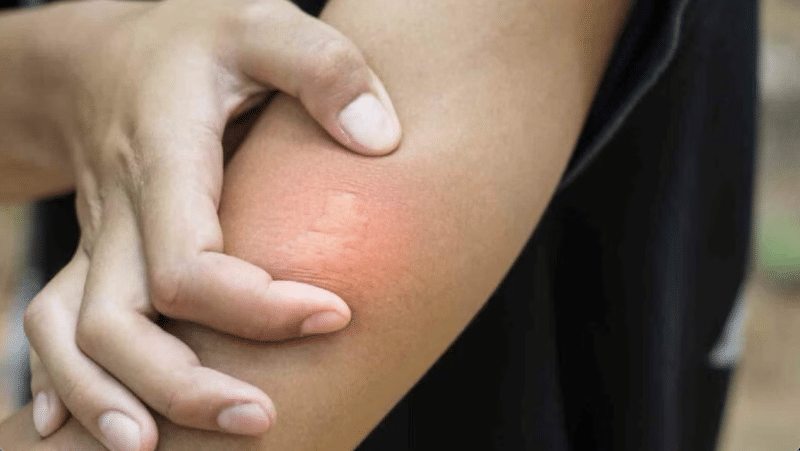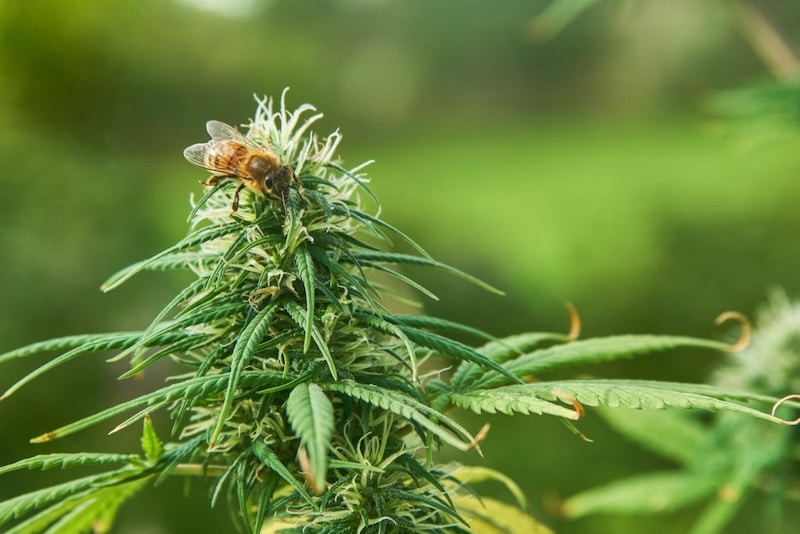Updated: April 22, 2024
Contents
- What are Bee Stings?
- Types of Bee Stings
- Honey Bee Stings: Stingers and Venom
- Why do Bees Sting?
- Symptoms of a Bee Sting
- What Does a Bee Sting Look Like?
- Causes of Bee Stings
- Quotes from our Beekeepers
- How to Prevent a Bee Sting
- How to Treat a Bee Sting
- Bee Sting FAQ’s
What are Bee Stings?
Bee stings are small wounds caused when a bee punctures the skin of a perceived attacker with its stinger. These are different than insect bites, and include the injection of venom into the attacker’s body. The venom, known as apitoxin, is comprised of enzymes, amino acids (including histamines), and peptides. The amino acid Melittin makes up almost half of the venom by dry weight and is the primary cause of the immediate pain of a bee sting. Histamines make up about 9%, and cause the longer-term swelling and itching that follow initial pain.
Types of Bee Stings
The most common bee stings are from honey bees, bumble bees and wasps, and for the majority of people, pose no health risk. While most bees can sting, some species are stingless, defending themselves by biting. With smooth stingers, bumble bees and wasps can sting multiple times; with barbed stingers, honey bees can sting only once.
Honey Bee Stings
A honey bee’s barbed stinger holds fast in the wound, and is torn out of the bee’s body when she flies away. Most honey bees die after they sting; they are the only bees to die after stinging. When honey bees sting they release alarm pheromones that signal a threat to nearby bees, who may join in defense of the hive. Dozens of bees defending their hive from attack should not be confused with swarming, where thousands of bees leave their nest to form a new colony. Bee swarming is a harmless activity, and a time when honey bees are at their most docile.
Bumble Bee and Wasp Stings
Bumble bees and wasps have relatively smooth stingers and can sting multiple times. Bumble bee stings are slightly more painful than honey bee stings, and wasps stings are even more painful.
While the venom in different bee species is fairly similar, there are enough differences in their apitoxin chemistry to make some people allergic to the sting of one type of bee and not allergic to the others.
Honey Bee Stings: Stingers and Venom
It is widely believed that a worker honey bee can sting only once. This is a partial misconception; it is true that their stingers are barbed so they lodge in the victim’s skin, which causes the stinger to tear loose from the bee’s abdomen. This results in the death of the bee. However, this only happens if the skin of the victim is sufficiently thick, such as a human’s. Bees with barbed stingers can often sting other insects without harming themselves. Honey bees are the only member of the hymenoptera order with a strongly barbed stinger, though yellow jackets and some other wasps have small barbs.
The three proteins in honey bee venom that are important allergens are phospholipase A2, hyaluronidase, and acid phosphatase.
Drone bees, the males, do not have stingers. The female bees, worker bees and queens, are the only ones that can sting, and their stingers are modified ovipositors (female reproductive organs). While the queen bee’s stinger is smoother than that of her workers, meaning she can sting multiple times if necessary, she rarely leaves the hive. Her sting is not for defending the hive, but rather for neutralizing her rival queens before they can emerge from their cells to challenge her.
The worker bee stinger consists of three parts: a stylus and two barbed slides (or lancets) on either side of the stylus. The barbed slides move alternately up and down the stylus so when the barb of one slide catches and retracts, it pulls the stylus and other barbed slide into the wound. This process is repeated to draw the stylus fully into the wound and encourage the release of as much venom as possible.
Why Do Bees Sting?
The purpose of stinging is purely defensive, and is meant to scare away attackers, not kill them. Bees are not aggressive, and sting only when they or their colony is threatened. The sting’s injection of apitoxin into the victim is accompanied by the release of alarm pheromones, and the death of the bee (after they have stung a mammal) accelerates the proliferation of the alarm pheromone. This will attract other bees to the location, where they will join their fallen sister in her defensive behaviors until there is no longer a threat. The alarm pheromone emitted when a bee stings anther animal smells like bananas.
Symptoms of a Bee Sting
According to the Mayo Clinic, bee stings may present as mild, moderate or severe:
- Mild stings, which are by far the most common, are characterized by sharp, burning pain, with a red welt and slight swelling around the sting area. These last for only a few hours.
- Moderate stings include both sharp pain and extreme redness around the sting, with swelling that gradually enlarges over the next day or two. Symptoms of moderate stings usually go away within 5-10 days.
- Severe stings involve an intense allergic reaction known as anaphylaxis, which can include hives; difficulty breathing; throat swelling; a weak, rapid pulse; nausea, vomiting or diarrhea; dizziness, fainting or loss of consciousness. Anaphylaxis can be life threatening and requires emergency treatment.
If stung more than a dozen times, the accumulated venom can cause a reaction similar to anaphylaxis. This can be serious for children, older adults and those with heart or breathing problems, who should seek emergency medical care.
To learn more about bee sting symptoms, visit https://www.mayoclinic.org/diseases-conditions/bee-stings/symptoms-causes/syc-20353869.
What Does a Bee Sting Look Like?
Bee stings usually appear as a swollen, red welt, with a white spot where the stinger was injected into your skin. Honey bee stings often include the stinger — a black needle with a bulbous end. Because honey bee stingers are barbed, they become attached to the skin, and the stinger and the venom sack are torn away from the bee after she stings and flies away.
Causes of Bee Stings
Bee stings only occur when bees feel that they or their hive are threatened. Under normal circumstances, bees are docile, ignore people, and are preoccupied with foraging for food and bringing it back to their hive. Most bee stings happen when people accidentally step on or sit on a bee, if they make contact while trying to swat a bee or wasp away, or if they come too close to a hive.
Professional and hobbyist beekeepers wear bee suits, gloves and masks to help protect themselves from bee stings and treat hives with smoke to calm bees. Even with precautions, beekeepers can be stung, but most see this as an occasional annoyance.
Quotes and Stories from our Beekeepers
I got stung by yellow jackets last year and that was WAY more painful. Bees are just defending their homes while we are invading and potentially stealing their food! Stand your ground, bees. — Sarah Long, Beekeeper, Chicago
One of the funny things about getting stung so often is how desensitized we can get — I’ve started finding dead bees in my shoes and pants and not realizing I’ve been stung until much later in the day. — Daniel Ephlin, Beekeeper, Boston
I recall fondly when a long-term client shared with me data saying that beekeepers live longer lives. We discussed different hypotheses, from molecular causes such as venom, to holistic benefits like the biophilic effects of connections to nature that lower stress. From that conversation to today, I say that every time someone gets stung, that’s another day on their life. See ya when I’m 150 years old, y’all. — Noah Wilson-Rich, CEO and Chief Scientific Officer, Boston
Bee stings for me are more like jump scares in movies. I don’t scream “ahh!” because it hurts but because I didn’t see it coming. I wish I was braver! – Ronnie Thompson, Special Ops Beekeeper and Researcher, Boston
How to Prevent Bee Stings
Bee sting prevention is simple:
- Don’t walk barefoot on the bare ground.
- Check for bees before you sit down outside.
- When gardening, look for bees on flowers when pruning, deadheading or transplanting.
- Cover food and beverages when eating outdoors. Some bees are attracted to the scent of food, especially sugary drinks and desserts.
- Don’t swat at bees — this will only provoke them and make them more inclined to go into protective mode.
- Check eaves when painting or doing repair work, as wasps can nest there.
- Don’t throw things at bees, beehives or wasp nests.
- Have professionals remove wasp nests and professional beekeepers remove swarms if they appear on your property.
How to Treat a Bee Sting
- Get away from the place where you were stung. The bee who stung you may have released alarm pheromones that will bring other bees to help defend the hive.
- Remove the stinger. Look closely at the area of the bee sting — if you see a small black needle, that’s the stinger. Gently pinch or scrape it to pull it out; be careful to avoid squeezing the venom sac. Do this as soon after you’ve been stung to minimize the amount of venom that enters your body.
- Treat the area around the sting. Wash with soap and water first to avoid infection, then apply an antihistamine like Benadryl to reduce swelling and itching. Ice is also an effective method to reduce swelling and itching. Take Advil, Aleve or Tylenol to reduce the pain. You can also apply hydrocortisone or calamine lotion to reduce itching.
- Watch for signs of anaphylaxis. While rare, if they occur, you’ll most likely experience symptoms within two hours. If you have symptoms of anaphylaxis, call 911. Keep in mind that approximately 10 percent of people will develop severe redness and swelling after a sting; this is called a large local reaction. The area may become large (four inches or more) over one to two days and then slowly resolve over five to 10 days. Having a large local reaction does not mean that you will have a severe allergic reaction (anaphylaxis) if you are stung again. Only about five to 10 percent of people who have a large local reaction will have anaphylaxis if stung in the future.
Bee Sting FAQ’s
Q: Are bee stings dangerous?
A: For the majority of people, bee stings are only an annoyance, with most pain, itching and swelling gone after a few hours. Some people, though, are allergic to bees, and can go into anaphylactic shock after being stung. This is a dangerous condition that requires emergency care.
Q: Why do bees attack people?
A: Except when provoked, bees do not attack people. Unless you threaten bees or their hives, they will not sting you.
Q: Do all bees sting?
A: The most common bees—honeybees, bumblebees and wasps—can sting. Some species don’t sting but defend themselves by biting.
Q: Can bees sting many times?
A: Wasps and bumblebees have smooth stingers and can sting more than once. Honeybees have barbed stingers that become lodged in skin and so can sting only once.
Q: Is it dangerous to have beehives near people?
A: Honeybees have been bred over thousands of years to be docile. Hives can be safely placed near buildings, as long as they are out of high traffic areas. Many people keep bees in their yards, and many businesses have beehives on their roofs.
Q: What can I do to avoid bee stings?
A: There are many common-sense ways to avoid being stung by bees: don’t walk barefoot in the grass; stay out of floral meadows; look for bees when gardening; don’t wear bright clothes or floral perfume when in places with many flowers; cover food and beverages when eating outside; stay 25’ away from hives and wasp nests.
Q: What should I do if stung by a bee or wasp?
A: Get to a place of safety. Remove the stinger. Treat the sting area to reduce itching and swelling. Watch for signs of anaphylactic shock. Call 911 if you think you are experiencing anaphylactic shock.








